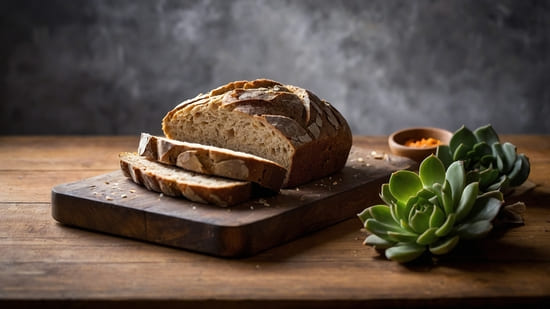
Alice Brown
Experienced and passionate pastry chef with a flair for creative desserts. Adept at crafting delicious treats, utilizing quality ingredients, and maintaining high standards of excellence in culinary artistry.

Experienced and passionate pastry chef with a flair for creative desserts. Adept at crafting delicious treats, utilizing quality ingredients, and maintaining high standards of excellence in culinary artistry.
The Gluten-Free Artisan Bread is a type of bread that is made without any gluten, perfect for those who are intolerant or allergic to this protein. It originates from the innovative kitchens of contemporary chefs who have put their minds to work to create food suitable for different dietary needs.
It is prepared using simple and naturally gluten-free ingredients, ensuring a fluffy, chewy, perfectly textured and crusty finish. This bread is a great addition to brunches, breakfasts, and dinner parties, especially when you have guests with varying dietary needs.
It's also a perfect introduction to gluten-free baking, with its easy process and minimal active prep time. Plus, the aroma of fresh bread wafting out of the oven is a surefire way to pique everyone's appetite. Main ingredients include brown rice flour, potato starch, tapioca flour, psyllium husk powder - all simple, healthy, and gluten-free.

In a small mixing bowl, whisk together the warm water and sugar until dissolved. Add in the yeast, allow it to bloom by letting it sit for about 10-15 minutes until frothy. Whisk in the psyllium husk powder and let the mixture gel for about 10 minutes.
Next, in a medium mixing bowl, add brown rice flour, potato starch, tapioca flour, and salt. Whisk well to combine. Once the yeast mixture has rested, add it to the dry ingredients.
Stir thoroughly with a wooden spoon or spatula until the dough looks shaggy. Continue kneading the dough for at least 3 minutes until it becomes a cohesive yet sticky ball.
Once your dough is ready, turn it out onto your work surface and shape it into a ball. Lay this ball of dough into your prepared proofing basket, and let it rise for 30 minutes.
Then, preheat your oven along with a dutch oven or a loaf pan. Once the oven is preheated, flip the risen dough onto a piece of parchment paper, then carefully lift it into your hot dutch oven or loaf pan.
Bake for 35 minutes with the lid on, then lower the temperature and bake for another 30-35 minutes without the lid. Once baked, cool the bread before cutting and serving.
Psyllium husk powder is a key ingredient and should never be substituted. Using it provides the bread with the required texture and fluffiness. Other gluten-free flours can be experimented with, but the results may vary greatly.
Always allow the bread to cool completely before storing. This will prevent it from becoming soft or gummy. The bread can be stored in a bread wrap or bag at room temperature for 2-3 days, but it tastes the best within the first 24 hours.
You can also refrigerate the bread for up to 5 days or freeze for up to a month. Remember to toast the bread before serving it if it has been refrigerated or frozen.
When shaping your dough, if it sticks to your hands, moisten them slightly with water. To get the best results from your yeast, ensure the temperature of the water is correct. Too hot and it will kill the yeast, too cold, and the yeast won't activate.
Also, don't rush the baking process. Gluten-free bread requires the right mix of resting and baking times for the perfect result.
Yes, you can replace the cane sugar with regular white sugar, however, keep in mind that cane sugar adds a little extra moistness to the bread. The taste difference won't be significant though.
A proofing basket is used to support the shape of the bread as it rises. If you don't have one, you can just use a regular bowl. Just make sure to dust it liberally with flour to prevent the dough from sticking to the sides.
Yes, you can add a variety of seeds or nuts to the dough just before baking. This might change the texture slightly, but it will also add an extra dimension of flavor. Make sure any additions are finely chopped to avoid affecting the integrity of the bread.
Absolutely! This gluten-free artisan bread makes excellent sandwich bread. It's sturdy enough to hold together well, and it's soft and flavorful, which complements a variety of fillings.
Yes, you can definitely add herbs or spices to the dough to change the flavor of the bread. However, be careful not to add too much, or it may affect the texture and rising of the dough. Start with a small amount and adjust based on preference.